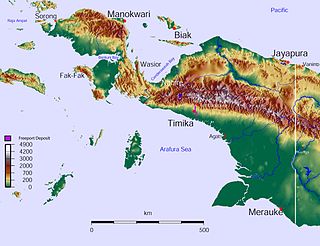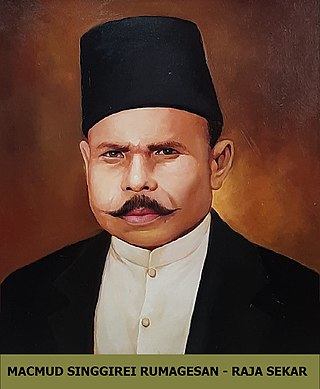Related Research Articles

West Papua, formerly Irian Jaya Barat, is a province of Indonesia located in the land of Papua. It covers most of the two western peninsulas of the island of New Guinea, the eastern half of the Bird's Head Peninsula and the whole of the Bomberai Peninsula, along with nearby smaller islands. The province is bordered to the north by the Pacific Ocean, to the west by Southwest Papua Province, the Halmahera Sea and the Ceram Sea, to the south by the Banda Sea, and to the east by the province of Central Papua and the Cenderawasih Bay. Manokwari is the province's capital and largest city. With an estimated population of 561,403 in mid-2022, West Papua is the least populous province in Indonesia after Southwest Papua, which was a part of West Papua until separated off in 2022.

The West Papuan languages are a proposed language family of about two dozen non-Austronesian languages of the Bird's Head Peninsula of far western New Guinea, the island of Halmahera and its vicinity, spoken by about 220,000 people in all. It is not established if they constitute a proper linguistic family or an areal network of genetically unrelated families.

The Bird's Head Peninsula or Doberai Peninsula, is a large peninsula that makes up the northwest portion of the island of New Guinea, comprising the Indonesian provinces of Southwest Papua and West Papua. It is often referred to as The Vogelkop, and is so named because its shape looks like a bird's head on the island of New Guinea. The peninsula at the opposite end of the island is called the Bird's Tail Peninsula. The peninsula just to the south is called the Bomberai Peninsula.

Sorong is the largest city and the capital of the Indonesian province of Southwest Papua. The city is located on the western tip of the island of New Guinea with its only land borders being with Sorong Regency. It is the gateway to Indonesia's Raja Ampat Islands, species rich coral reef islands in an area considered the heart of the world's coral reef biodiversity. It also is the logistics hub for Indonesia's thriving eastern oil and gas frontier. Sorong has experienced exponential growth since 2010, and further growth is anticipated as Sorong becomes linked by road to other frontier towns in Papua's Bird's Head Peninsula.

Raja Ampat, or the Four Kings, is an archipelago located off of the northwest tip of Bird's Head Peninsula, Southwest Papua province, Indonesia. It comprises over 1,500 small islands, cays, and shoals around the four main islands of Misool, Salawati, Batanta, and Waigeo, and the smaller island of Kofiau.

Domine Eduard Osok Airport is an airport in Sorong, Southwest Papua, Indonesia. It is one of the largest and busiest airports on the Bird's Head Peninsula. It replaced a smaller, former World War II airfield, Jefman Airport on the island of Jefman. The airport is named after Domine Eduard Osok, a pastor originating from Sorong and known for doing missionary work and spreading Christianity in Sorong and the surrounding parts.

Teminabuan is a small town in South Sorong Regency, Southwest Papua, Indonesia. The town serves as the administrative capital of South Sorong Regency. It had a population of 11,627 at the 2010 Census and 19,491 at the 2020 Census. The town is located in the southwestern-central part of the Bird's Head Peninsula. The area was bombed between January and March 1967. It is served by Teminabuan Airport.

South Sorong Regency is a regency of Southwest Papua province of Indonesia. It has an area of 6,594.31 km2, and had a population of 37,900 at the 2010 Census and 52,469 at the 2020 Census; the official estimate as at mid 2022 was 53,884. The administrative centre is the town of Teminabuan.
Tehit is a Papuan language of the Bird's Head Peninsula of New Guinea. Other spellings are Tahit, Tehid, and other names Kaibus, Teminabuan. Dialects are Tehit Jit, Mbol Fle, Saifi, Imyan, Sfa Riere, Fkar, Sawiat Salmeit.
West Bird's Head languages are a small family of poorly documented Papuan languages spoken on the Bird's Head Peninsula of New Guinea.

Operation Trikora was a combined Soviet-Indonesian military operation which aimed to seize and annex the Dutch overseas territory of Netherlands New Guinea in 1961 and 1962. After negotiations, the Netherlands signed the New York Agreement with Indonesia on 15 August 1962, relinquishing control of Western New Guinea to the United Nations.

The West New Guinea dispute (1950–1962), also known as the West Irian dispute, was a diplomatic and political conflict between the Netherlands and Indonesia over the territory of Dutch New Guinea. While the Netherlands had ceded sovereignty over most of the Dutch East Indies to Indonesia on 27 December 1949 following an independence struggle, it retained control over its colony on the western half of New Guinea. The Indonesian government claimed this territory as well, on the basis that it had belonged to the Dutch East Indies and that the new Republic of Indonesia was the legitimate successor to the former Dutch colony.

The Indonesian Irian Independence Party was a pro-Indonesian party in the Netherlands New Guinea. The party was established in 1946 by several pro-Indonesian students as a way to support the integration of Papua into the territory of Indonesia. The party's leader, Silas Papare was awarded as the National Hero of Indonesia posthumously on 14 September 1993.

The Berau Gulf, formerly the MacCleur Gulf, separates the Vogelkop (Doberai) and Bomberai Peninsulas of Western New Guinea. It opens on the Ceram Sea to the west and ends in Bintuni Bay to the east.
Marlina Flassy is an Indonesian anthropologist, who is the first woman to hold a deanship at Cenderawasih University, and is the first woman and indigenous Papuan to be appointed Dean of the Faculty of Social and Political Sciences there. In 2015 the Indonesian Ministry of Research and Technology awarded her its Golden Pin Award.

Machmud Singgirei Rumagesan was a king of Sekar and pro-integration activist from West Papua. He founded the movement Gerakan Tjendrawasih Revolusioner Irian Barat (GTRIB) in 1953, and became the member of Supreme Advisory Council in 1959. On 10 November 2020, Singgirei Rumagesan was posthumously declared a National Hero of Indonesia for his lifelong efforts to unite West Irian with Indonesia.

Southwest Papua is the 38th province of Indonesia to be created, and was split off from West Papua on 8 December 2022. Despite being named southwest, it is a misnomer and this province is actually located in the northwest edge of Papua. The province comprises the Greater Sorong area which consists of Sorong City, Sorong Regency, South Sorong Regency, Maybrat Regency, Tambrauw Regency, and Raja Ampat Regency. The Bill (RUU) on the Establishment of the Southwest Papua Province was passed into law and therefore it became the 38th province in Indonesia.

The Salawati Kingdom is the Islamic kingdom that once stood in Salawati Island, Raja Ampat Regency, Southwest Papua. The center of the Salawati kingdom was located in the Samate village which is currently located in the North Salawati district.
Petuanan Teminabuan, also called Petuanan Kaibus, is one of the four petuanan in the traditional government system of the Tehit people. This petuanan is considered the most influential among the three other petuanans. At first, Petuanan Teminabuan was under the area of influence of the Sailolof Kingdom which was centered in Sailolof, Salawati Island.
The Onin Peninsula is a peninsula that forms part of the larger Bomberai Peninsula in the Fakfak Regency in West Papua. The Onin language is named after this peninsula.
References
- 1 2 Ananta, Aris (2015). Demography of Indonesia's Ethnicity. Evi Nurvidya Arifin, M. Sairi Hasbullah, Nur Budi Handayani, Agus Pramono. Singapura: Institute of Southeast Asian Studies. ISBN 978-981-4519-88-5. OCLC 1011165696.
- 1 2 3 4 5 6 7 8 9 10 11 12 13 Handoko, Soewarto; Rumbewas, Dominggus; Sawaki, Marthen; Krenak, Thonce; Sunaryo, Suristina (1983). Isi dam Kelengkapan Rumah Tangga Tradisional Menurut Tujuan, Fungsi dan Kegunaannya Daerah Irian Jaya (PDF) (in Indonesian). Indonesia: Ministry of Education and Culture . Retrieved 2022-02-10.
- ↑ Nurhabsyah (2005). "Gerakan Bawah Tanah Cara Rakyat Irian Jaya Menentang Kekuasaan Pemerintahan Kolonial Belanda" (PDF). Fakultas Sastra Jurusan Sejarah Universitas Sumatera Utara. p. 5. Retrieved 4 March 2021.